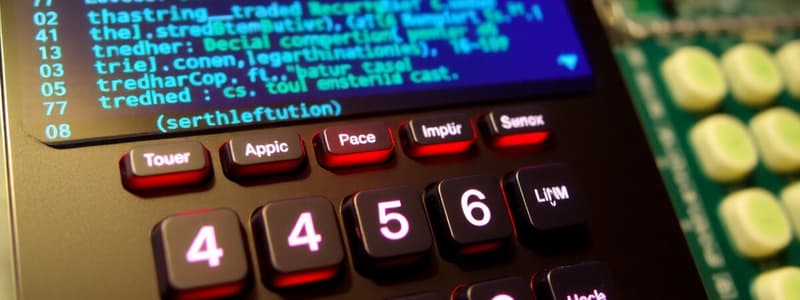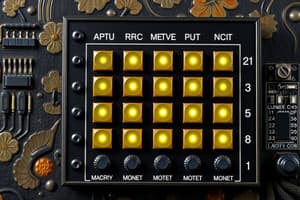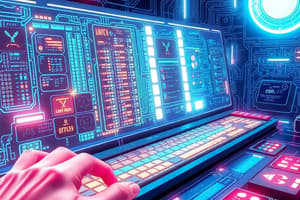Podcast
Questions and Answers
What does the function getKey() do when a key is pressed?
What does the function getKey() do when a key is pressed?
- Returns the key value without repeating automatically. (correct)
- Repeats the key value continuously until released.
- Requires an eventListener to return a key value.
- Only tracks when a key is released.
What are the dimensions of the keypad as defined in the content?
What are the dimensions of the keypad as defined in the content?
- 5 rows and 4 columns
- 4 rows and 4 columns (correct)
- 4 rows and 3 columns
- 3 rows and 5 columns
What does the digitalRead() function return?
What does the digitalRead() function return?
- The resistance value of the pin
- The status of the pin as HIGH or LOW (correct)
- The voltage level of the pin
- The current flowing through the pin
Which pins are connected to the row pinouts of the keypad?
Which pins are connected to the row pinouts of the keypad?
What is the purpose of the Keypad object created in the code?
What is the purpose of the Keypad object created in the code?
In which situation does the output of a pull-up resistor become LOW?
In which situation does the output of a pull-up resistor become LOW?
What determines if a switch acts as normally open (NO) or normally closed (NC)?
What determines if a switch acts as normally open (NO) or normally closed (NC)?
In the provided code, how are the keys on the keypad arranged?
In the provided code, how are the keys on the keypad arranged?
What happens to the switches when the system is initialized according to the content?
What happens to the switches when the system is initialized according to the content?
What should be declared in the setup() function for pin 10 when it's used to control an LED?
What should be declared in the setup() function for pin 10 when it's used to control an LED?
Which of the following statements about the getKey() function is true?
Which of the following statements about the getKey() function is true?
When using digitalRead(), what parameter must be provided?
When using digitalRead(), what parameter must be provided?
What character represents the key at the first row and last column in the keypad?
What character represents the key at the first row and last column in the keypad?
If a pushbutton is unpressed, what will be the output when using a pull-up resistor?
If a pushbutton is unpressed, what will be the output when using a pull-up resistor?
Which of the following correctly describes the purpose of pull-up resistors?
Which of the following correctly describes the purpose of pull-up resistors?
What will the variable 'val' store in the provided example code?
What will the variable 'val' store in the provided example code?
What is a primary feature of the keypad library mentioned?
What is a primary feature of the keypad library mentioned?
How many buttons can a keypad typically have while using only 8 lines for connection?
How many buttons can a keypad typically have while using only 8 lines for connection?
What effect does using delay statements in the code have on the keypad?
What effect does using delay statements in the code have on the keypad?
Why is multiplexing used with keypads?
Why is multiplexing used with keypads?
What common device primarily uses numeric keypads?
What common device primarily uses numeric keypads?
Which statement about the digitalWrite function in the example is true?
Which statement about the digitalWrite function in the example is true?
What happens if multiple delay statements are scattered throughout the code?
What happens if multiple delay statements are scattered throughout the code?
What is the typical function of the HIGH status in the provided code example?
What is the typical function of the HIGH status in the provided code example?
What happens when a switch is pressed in the circuit described?
What happens when a switch is pressed in the circuit described?
In the code provided, what does the function 'keypad.getKey()' return when a key is not pressed?
In the code provided, what does the function 'keypad.getKey()' return when a key is not pressed?
What is the primary function of the LiquidCrystal() function in LCD interfacing?
What is the primary function of the LiquidCrystal() function in LCD interfacing?
Which of the following is a characteristic of an LCD module?
Which of the following is a characteristic of an LCD module?
What does the line 'Serial.println(key);' accomplish in the provided code?
What does the line 'Serial.println(key);' accomplish in the provided code?
Which option best describes the relationship between column pins and row pins in the provided circuit?
Which option best describes the relationship between column pins and row pins in the provided circuit?
When configuring the data lines for an LCD, how many lines can be left unconnected if using 4 data lines?
When configuring the data lines for an LCD, how many lines can be left unconnected if using 4 data lines?
What is the purpose of driving a column pin low in the context of a keypad?
What is the purpose of driving a column pin low in the context of a keypad?
What does the myLCD.begin(cols, rows) function initialize?
What does the myLCD.begin(cols, rows) function initialize?
Which variable name is used in the example to refer to the LCD display?
Which variable name is used in the example to refer to the LCD display?
What is the purpose of the myLCD.clear() function?
What is the purpose of the myLCD.clear() function?
What does the Vo pin control in a 16x2 LCD display?
What does the Vo pin control in a 16x2 LCD display?
What does the setCursor() function accomplish?
What does the setCursor() function accomplish?
Which pins are considered the control pins for the LCD?
Which pins are considered the control pins for the LCD?
How is maximum contrast achieved on the 16x2 LCD display?
How is maximum contrast achieved on the 16x2 LCD display?
What is the purpose of the RS, RW, and E control pins?
What is the purpose of the RS, RW, and E control pins?
What is the purpose of the RW pin in the LiquidCrystal function?
What is the purpose of the RW pin in the LiquidCrystal function?
Which of the following parameters are required for setting up a LiquidCrystal object?
Which of the following parameters are required for setting up a LiquidCrystal object?
How many maximum characters can be displayed in each row of a 16x2 LCD?
How many maximum characters can be displayed in each row of a 16x2 LCD?
Which of the following data lines are optional when using the LiquidCrystal library?
Which of the following data lines are optional when using the LiquidCrystal library?
If the RW pin is not used, what must be done?
If the RW pin is not used, what must be done?
What does the LiquidCrystal function primarily control?
What does the LiquidCrystal function primarily control?
When initializing the LiquidCrystal object in code, which parameter is not optional?
When initializing the LiquidCrystal object in code, which parameter is not optional?
What is the function of the 'Enable' pin in the LiquidCrystal setup?
What is the function of the 'Enable' pin in the LiquidCrystal setup?
Flashcards
digitalRead() function
digitalRead() function
Reads the status (HIGH or LOW) of a specified digital pin on an Arduino.
HIGH/LOW
HIGH/LOW
Possible states a digital pin can be in, representing 'on' and 'off' in Arduino programming.
digital pin
digital pin
A pin on an Arduino board connected to a digital circuit.
pull-up resistor
pull-up resistor
Signup and view all the flashcards
push-to-make switch
push-to-make switch
Signup and view all the flashcards
push-to-break switch
push-to-break switch
Signup and view all the flashcards
Arduino pinMode()
Arduino pinMode()
Signup and view all the flashcards
logic 1/logic 0
logic 1/logic 0
Signup and view all the flashcards
Keypad Interfacing
Keypad Interfacing
Signup and view all the flashcards
Numeric Keypad
Numeric Keypad
Signup and view all the flashcards
Keypad Library
Keypad Library
Signup and view all the flashcards
Non-blocking
Non-blocking
Signup and view all the flashcards
Multiplexing
Multiplexing
Signup and view all the flashcards
Delay function
Delay function
Signup and view all the flashcards
Unresponsive Keypad
Unresponsive Keypad
Signup and view all the flashcards
Microcontroller
Microcontroller
Signup and view all the flashcards
getKey() function
getKey() function
Signup and view all the flashcards
Event Listener
Event Listener
Signup and view all the flashcards
Keymap
Keymap
Signup and view all the flashcards
Keypad array (keys)
Keypad array (keys)
Signup and view all the flashcards
Row Pins
Row Pins
Signup and view all the flashcards
Column Pins
Column Pins
Signup and view all the flashcards
Initial switch state
Initial switch state
Signup and view all the flashcards
What is an LCD?
What is an LCD?
Signup and view all the flashcards
What is a LiquidCrystal object?
What is a LiquidCrystal object?
Signup and view all the flashcards
Serial Communication
Serial Communication
Signup and view all the flashcards
Serial.begin()
Serial.begin()
Signup and view all the flashcards
Serial.println()
Serial.println()
Signup and view all the flashcards
No_KEY
No_KEY
Signup and view all the flashcards
keypad.getKey()
keypad.getKey()
Signup and view all the flashcards
LiquidCrystal Library
LiquidCrystal Library
Signup and view all the flashcards
LCD Pin Connections
LCD Pin Connections
Signup and view all the flashcards
RS Pin (Register Select)
RS Pin (Register Select)
Signup and view all the flashcards
RW Pin (Read/Write)
RW Pin (Read/Write)
Signup and view all the flashcards
Enable Pin
Enable Pin
Signup and view all the flashcards
Data Pins (D0-D7)
Data Pins (D0-D7)
Signup and view all the flashcards
16x2 LCD
16x2 LCD
Signup and view all the flashcards
LCD Backlight
LCD Backlight
Signup and view all the flashcards
myLCD.begin(cols, rows)
myLCD.begin(cols, rows)
Signup and view all the flashcards
myLCD.clear()
myLCD.clear()
Signup and view all the flashcards
myLCD.setCursor(x, y)
myLCD.setCursor(x, y)
Signup and view all the flashcards
cols & rows
cols & rows
Signup and view all the flashcards
E Pin
E Pin
Signup and view all the flashcards
DB0 to DB7 Pins
DB0 to DB7 Pins
Signup and view all the flashcards
Study Notes
Push Button Interfacing
- Switches either close or open a circuit, controlling devices
- Toggle, rotary, and magnetic switches are examples
- Push-to-make switches complete a circuit when pressed, like a keypad button
- Push-to-break switches complete a circuit when the button is not pressed, like turning a light off when the switch isn't pressed.
- Many push buttons function as both, depending on the circuit connections
digitalRead() Function
- Reads the logic level (HIGH or LOW) from a specified digital pin.
- Syntax:
digitalRead(pin)wherepinis the Arduino pin number. - Returns HIGH or LOW.
Pull-up Resistors
- Forces a wire signal to logic HIGH (ON) in the absence of input.
- Output is HIGH when the switch is open, LOW when it's closed
- This type of resistor is used with switches usually in situations where the switch is open by default.
Pull-down Resistors
- Forces a wire signal to logic LOW (OFF) in the absence of input.
- Output is LOW when the switch is open, HIGH when it's closed
Keypad Interfacing
- Numeric keypads are used in many electronic devices.
- 4x3 or 4x4 keypads reduce connection lines by multiplexing.
- Keypad libraries simplify their use with microcontrollers, such as
Keypad. - Libraries are non-blocking, allowing control even during significant processing.
getKey()Function: returns a key value when a key is pressed but does not repeat unless configured.
LCD Interfacing
- LCDs, Liquid Crystal Displays, are used to show messages in digital devices.
- LCD modules include drivers and controller in a package.
- Typical LCDs are 16x2, meaning 2 rows of 16 characters each.
- Function
LiquidCrystal()creates an LCD variable for use. begin()function sets up the LCD with its dimensions (columns and rows).print()function displays data on the LCD.clear()function clears the screen.setCursor()function changes the cursor position.
Studying That Suits You
Use AI to generate personalized quizzes and flashcards to suit your learning preferences.




